The subtleties of the design of a wicker fence
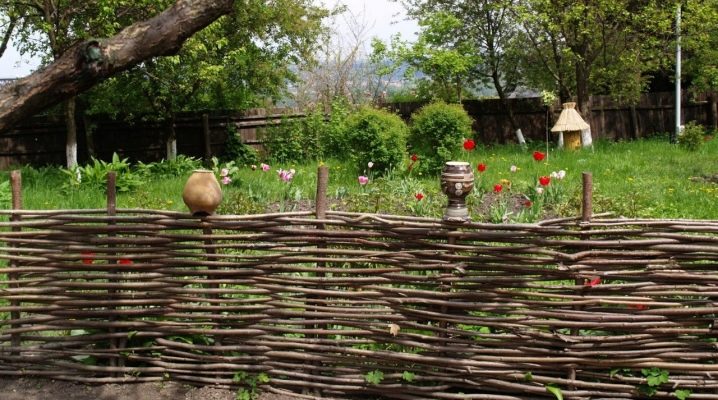
There is a great variety of types of fences that can protect a land plot and a house from outside intrusion. However, such a primitive and outdated option, considered by many people, as a wicker fence, is able to protect a little worse than more solid structures. At the same time, everyone can create it, and the appearance will delight even those who do not make aesthetic compromises.

Peculiarities
Even 80-100 years ago, a wicker fence could be found incomparably more often than now. The main material for it is available and relatively inexpensive, the protective structure is light. These advantages persist to this day, and an emphasized archaic look from a disadvantage can easily be turned into dignity, thereby beating the surroundings of a country house. Moreover, such a design is easily formed by hand, you do not have to look for professionals and wait for them to complete the order.
The classic braid is a lightweight barrier of a chaotic structure. There is no need to process the material, it is even contraindicated by technology. The overwhelming majority of such fences do not exceed 150 cm in height, since the fragility of raw materials does not allow them to be made very high. We'll have to put up with both the presence of cracks and the impossibility of creating a truly blank wall.
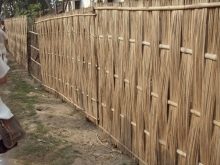
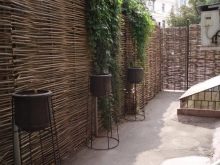
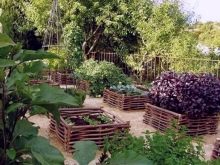
It is recommended to cover relatively small areas with wattle fences or set them up as auxiliary fences on the territory of the dacha or vegetable garden.
An alternative application is the demarcation of adjacent areas, attractive by minimal shading. As a result, your interests and those of your neighbors will not be affected at all.
High-quality preparation for work is of great importance, only it allows you to finish the job quickly and at the lowest cost. This is not just a fence being hammered from a picket fence, but technical knowledge and the ability to handle a tool are indispensable here.
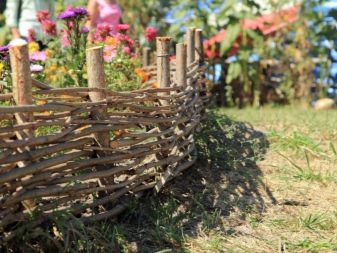
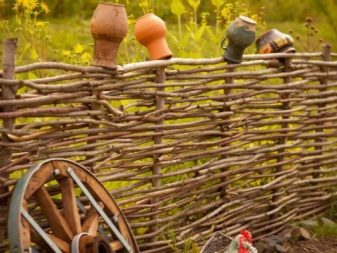
Material
For many centuries, wicker hedges have been made from willow (willow), willow vine and hazel wood. The three plants, for all their differences, have oblong branches with a flat surface that bend easily. Some craftsmen use wild-growing reeds (cattails), which are more fragile than branches of trees and shrubs. Bamboo wattle watts are stronger than ordinary ones, only the raw materials will need to be bought, for obvious reasons it will not be possible to prepare them.
If willow is chosen, there is no need to calculate its consumption, it is recommended to take as much as you see fit. Most often, an armful of branches allows you to form a canvas 50 cm long and the same height. More precisely, you cannot say without knowing what the diameter of the vine is and how tight the weaving you want to make. Theoretically, you can take young shoots of any tree and even shrub no shorter than 100 cm.But for beginners, it is better to stop at proven options, they give a more stable and predictable result.
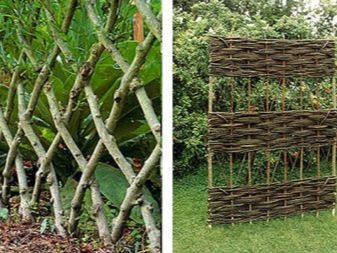
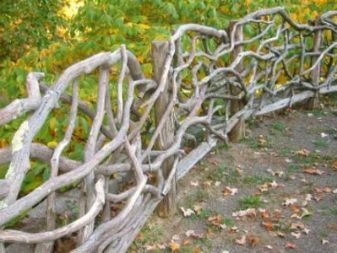
It is necessary to harvest willow trees either in the spring, until the snow has melted, or in the fall, when the snow cover has just settled. The reason is simple: the speed of movement of juices is limited, leaves are the least.
Try to choose the shoots as even and long as possible; if you do not start construction immediately, take care of drying the collected branches.
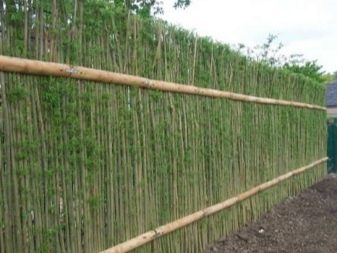
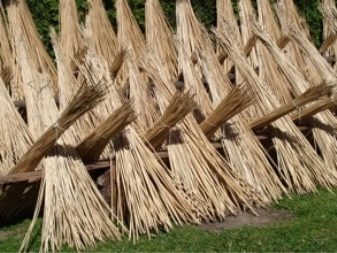
Instead of natural wood, you can make a wicker made of PVC, and its decorative properties will be no worse. Such a solution will allow the fence to maintain its functional characteristics and appearance for decades.If you suddenly need to move the fence (when moving, building, new land surveying) - it will not be difficult.
Polyvinyl chloride does not fade even in bright sun, it is not afraid of severe cold and extreme heat. All care comes down to wiping with a special agent and restoring the anti-corrosion coating on metal parts.

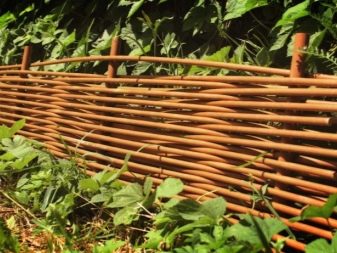
PVC wicker is much more varied in possible color than wooden structures, and by varying the pitch and size of the cell, you can make it really extraordinary. If you still firmly choose natural materials, you still need to consider the option using hazel. It is recommended that you cut the sticks in early spring and apply as soon as possible until the thickening sap hardens the material. Unlike willow, for the same reason, avoid harvesting in the fall and winter. You can increase the rigidity of the fence if you knit it from joints of 2, 3 or 4 rods.
The hazel tree will look prettier if you raise the vertical supports, adding decorations to them - flower baskets, painted earthenware dishes.

How to do it?
Operating procedure:
- Having prepared raw materials for the future fence, they begin to make support pillars. Most often, their role is played by the largest branches, the diameter of which exceeds 40 mm. If you use beams, boards, especially metal, the fence will last longer. But you only need to do this if it doesn't matter to you how natural the fence will look.
- Any step-by-step instruction assumes that the distance separating the supporting elements is 300-500 mm. By increasing it, you save material and speed up the process, and by decreasing it, you create a denser and more reliable wicker. The vertical connection requires the use of longitudinal ties, even in a very low barrier there cannot be less than five of them.
- Weaving from willow twigs begins only after the shoots are soaked in water for at least 7 days, if they are completely fresh, you can reduce the period by 1-2 days. After the branches have sufficient flexibility, the bark is removed from them using a specially prepared branch with limiters.
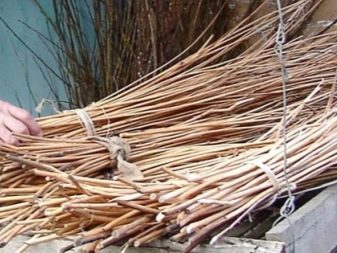
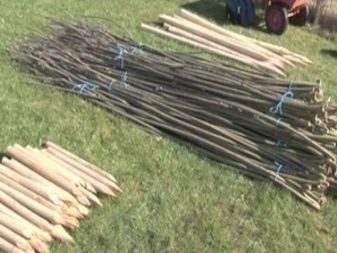
If you do not have such a device, use pliers or wire cutters. If the bark is difficult to remove, this means that the raw material is not yet ready!
- After cleaning the rods, treat them with an antiseptic; if you want to change the color, use a stain. But keep in mind that all branches are processed separately, and therefore, for large barriers, such processing will be too laborious and time-consuming. By the time you start working, prepare and place a tape measure, garden shears, a metal saw, a wooden hammer, a sledgehammer close to it. You will also need wire (for tightening the vine), fishing line or construction threads and a screwdriver.
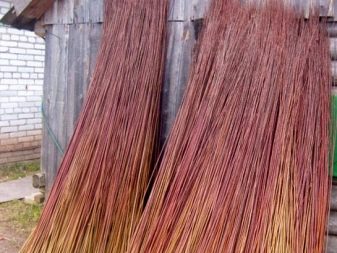
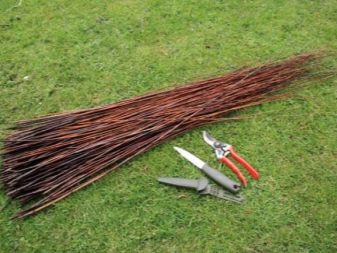
- The universal method of weaving is horizontal, it allows you to give the fence a density and strength unattainable for a vertical method. The fishing line (thread) is pulled, thereby denoting a straight line of the fence. This will be a reference point when placing supports (the gap between them is 1 m). Each support must be driven in at least 50 cm. If you nevertheless chose a horizontal connection method, you should tie the tops of the support elements with rails, preventing deviation to the side.
- Weave the rods into the gap between the adjacent posts from the thick edge, forming the number "8". The original pillar is circled in front, the next from the rear, the third again from the front side, and so they do as long as there is enough vine. To prevent the wattle from sliding to the ground, the lowest level of the rods is attached with wire to the stakes.
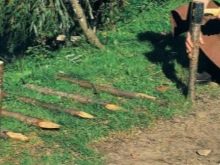
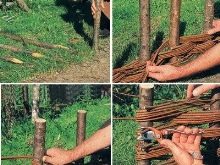
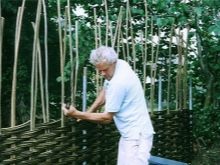
Weaving after the end of each rod begins with the pillar preceding the one on which it ended. This is very important, because otherwise the uniformity of the design cannot be achieved.
- When it is the turn to wind the final row of vines, the fixing bar is removed, and the rods themselves are tied up with wire.An important point: by placing the stakes not directly in the ground, but in plastic pipes, you will significantly increase the life of the fence. You can also make a wicker fence from an unedged board, the main thing is that it has sufficient flexibility. Such a structure will look more expensive than it actually costs, and during daylight hours, even alone it is easy to form up to 15 m of hedges.
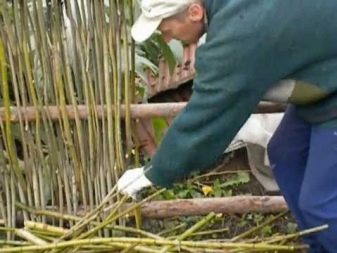
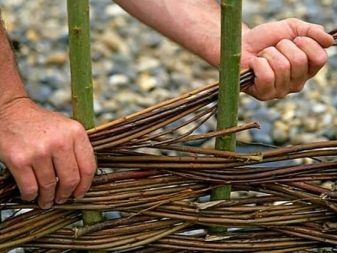
- Before starting work, decide on the purpose for which the fence will be used. So, wattle fences up to 100 cm are needed to decorate the site, their protective function is small. In many cases, such fences surround flower beds and separate areas in summer cottages and gardens. Setting the fence in sections means that there are left and right boundaries that coincide with the gap between the branches. Continuous installation consists in the fact that after each bar the next one is wrapped, a strip that does not have an end is created.
If ugly-looking places appear during work, just turn them inward so that you cannot see from the outside.
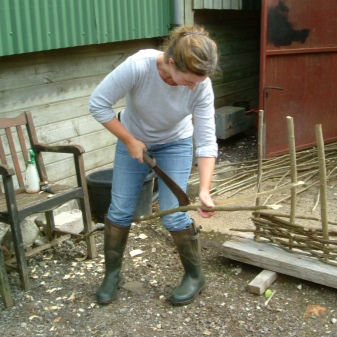

Weaving types
A wooden wattle fence can look very diverse and attractive, primarily because it uses complex patterns:
Chess spin implies the distribution of vines into bunches that are woven horizontally. If you pin thick (over 50 mm) branches on the upper pole, unfold the rods diagonally and attach the other end from below, you get a diagonal version of the chess twist. In its intervals, other prepared bundles should be woven.
If you take branches no thicker than 10 mm, they will also come in handy, but already for openwork weaving... In order not to look for such material everywhere for a long time, get it in any nursery.
But if openwork weaving is rather an ornament, a separate element, then alpine braid deservedly considered a full-fledged type of hedges. It is capable of both encircling the entire territory and becoming a barrier around climbing plants. The quality of the wood is very high and the product, if done correctly, will work for decades. Even the most attentive and critical environmentalists will not find anything wrong with this decision.
The supports should be concreted as carefully as possible, since the windage of the main structural elements is high.
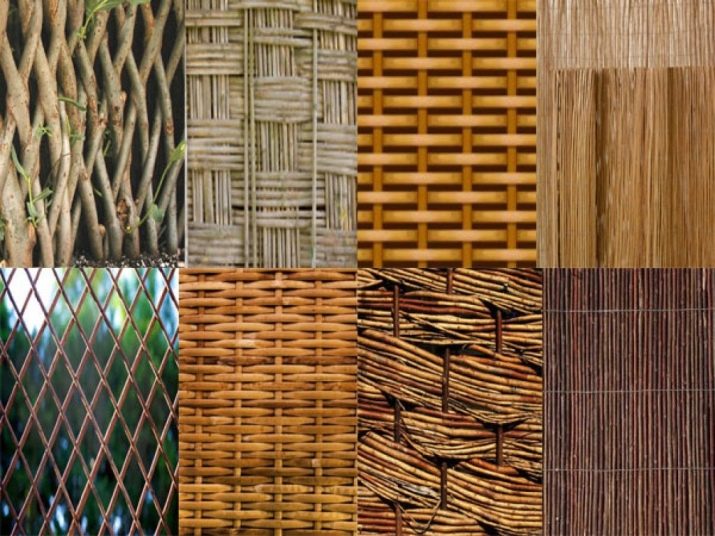
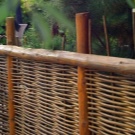
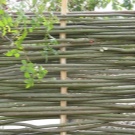
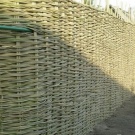
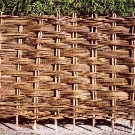
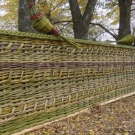
Planks need to be processed in advance: they are polished and carefully coated with a preparation that stops the development of microscopic fungi, reduces the negative effect of the sun, rain, hail and snow. A pair of planks is placed on each span, which are placed inside and outside, respectively. For your information: when weaving horizontal strips with vertical ones, make sure that they all bend on each side! You can simplify the work if you immediately prepare small grooves in the posts.
Initial fastening is done with nails or glue; subsequent boards do not require additional retention if the technology is fully followed. To reduce the risk and increase the service life, the wicker is coated with varnishes, drying oils and enamels. Austrian weaving can have a variety of patterns that are selected for the type of wood used, while taking into account the budget of the work.
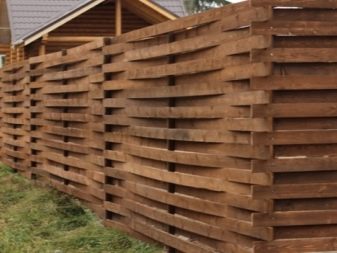

Classic vertical way weaving is no worse than the Austrian technique. Taking into account the difference in the size of the vine in the upper part of the shoot and at the roots, it is divided into pairs, alternately directing the thickest section up and down. This technique allows you to avoid differences in wattle density at different heights. If you use boards instead of branches, it is recommended to cover the upper lobes with another board, which gives the composition a completeness and makes it as resistant to bad weather as possible.
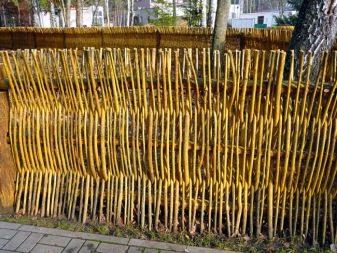

Sometimes the strips are attached from below, but in this case, they cannot be nailed along the top as well, otherwise the wet tree will deform. When using an undried board, remember: when it dries completely, intervals of 10 mm are formed.It is allowed to use a profile metal pipe, which is more reliable and stable, as vertical crossbeams.
If not wood, but plastic elements (picket fence) are used for wattle fence, the site can be considered relatively protected not only from intruders, but also from gusts of wind, from atmospheric vortices.
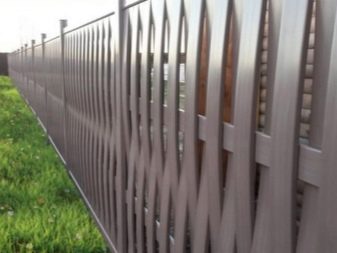
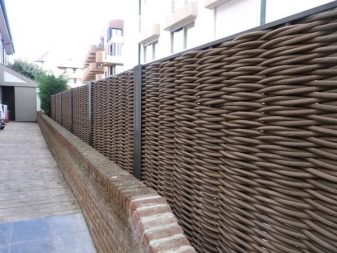
Only instructions from the manufacturer or an experienced specialist will give you exact recommendations on how to weave (connect) plastic blocks. But in any case, it will be necessary to control how smoothly the styling is going; by fixing the brackets to the pillars, it will be possible to put panels that will be held in place with screws or bolts.
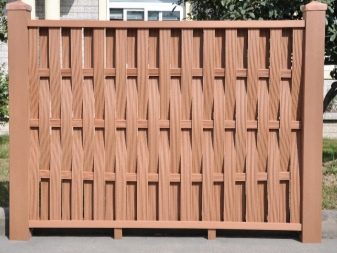
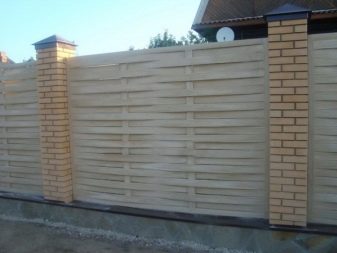
Decor
The simplest visual effect is achieved when dyeing the vine: the branches freed from the bark are impregnated with stain. You can make the wattle white if you treat it with hydrogen peroxide and keep it in a bright place for 48 hours. The brown color of the vine is given by boiling, and to make this color brighter, a little potassium permanganate is added to the boiling water. If you wish to achieve other colors, ordinary textile dyes will do. Both horizontal and vertical wattle fence after such processing will seem much more attractive than they were at first.
Combining a wicker fence and plants in flower beds, you can achieve an impressive result: an original border is built around the blooming greenery. There is nothing to think about protection, but the decorative function is realized as fully as possible. There are ready-to-use flower beds (0.9 m in diameter), fixed in the soil, but weaving throughout the territory can also be used as a decoration.
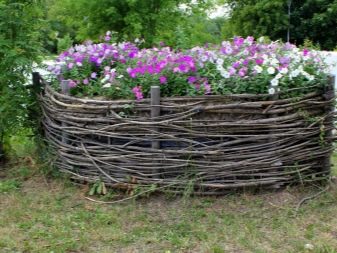
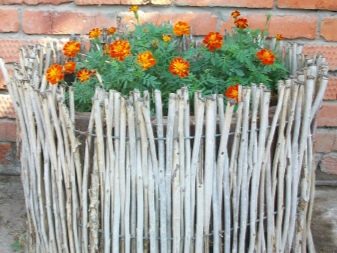
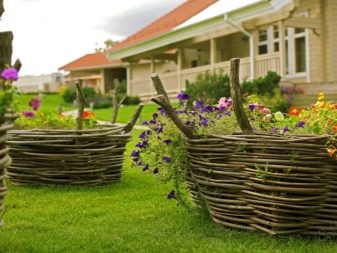

Sunflowers are organically combined with the wattle fence (with a close planting). If we talk about decorative objects, it is recommended to use everything that reminds of rural life: a cart wheel and stakes, wooden furniture and a stone garden. The imitation of birds sitting on the fence always looks attractive in any environment. The combination with stone is considered attractive - alpine slides, rock gardens and paved paths will be very appropriate.
As for flowers, it is usually recommended to place them along the wattle fence in pots and flowerpots, or to plant them side by side, but not to combine these two possible solutions. In addition to sunflowers, all climbing crops are considered compatible.
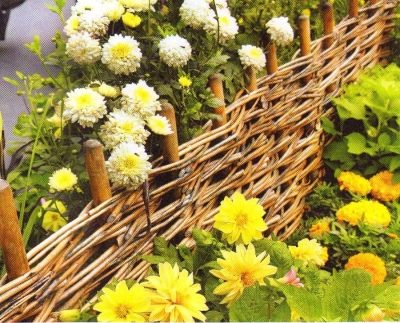



































































The comment was sent successfully.